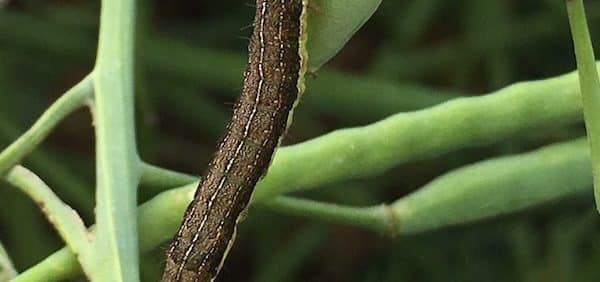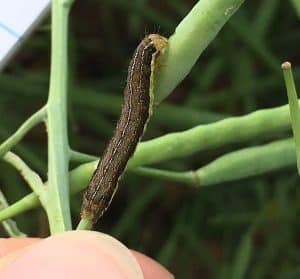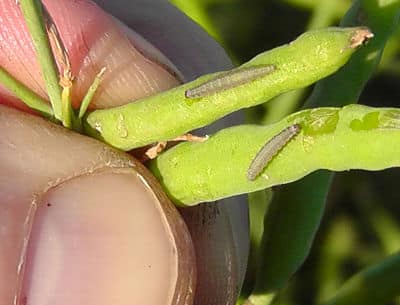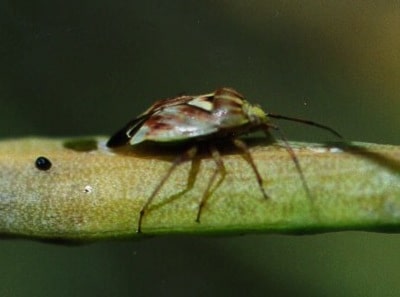Provincial insect reports indicate fairly low insect pressure so far in 2020, but local hot spots can occur. Over the next few weeks, farmers and agronomists will want to check pods for feeding from bertha armyworm, diamondback moth larvae, lygus and other pests.
If pod feeders are found, make accurate counts in at least four locations within each field. To save time, these locations can be in two pairs of two, spaced at leave 50 metres apart. Typically the more count locations the better, with 10 locations within the field generically recommended depending upon the insect. Make spray decisions based on thresholds.
Leaves act as an early warning system for most chewing canola pests at this stage. Missing leaves or holes in numerous leaves may give you a week or more of warning before pod chewing occurs.
Thresholds are set for each insect pests. They indicate the point at which a spray application will start to provide an economic return – so thresholds-based decisions are good for profits. By sticking to thresholds, you also protect the beneficial insects that will often keep a local pest population from exploding and maintain an overall lower population through the years.
Here are identifying features, scouting tips and links to thresholds for the three most common pod feeders in canola in Western Canada.
Bertha armyworm
Berthas come in brown, black and green shades. The green berthas are shinier than other green worms, and the yellow-orange stripe along each side is more pronounced, even on younger ones. Mature larvae are up to 1.5” long, making them considerably larger than diamondback moth larvae at late stages. Being part of the cutworm family, they also curl up when agitated.
Begin monitoring after peak flowering and continue until swathing. High numbers of this pest have been known to continue feeding in the swath. Swaths can’t be sprayed, but products are registered for control with as little as one day pre-harvest interval. Note that early control of this insect will preserve more yield if control is necessary.
At each scout location, mark out an area of one square metre and beat the plants growing within that area to dislodge the larvae. Shake vigorously and push the plants aside then count the number of berthas on the ground within that square metre. Remove leaf litter and trash, then pause a minute and wait for the larvae to begin moving around again to allow for easier counting. Scouting techniques. Thresholds will be around 20 bertha larvae per square metre in most situations. See the full thresholds table at canolaencyclopedia.ca.
Diamondback moth larvae
Diamondback moth larvae are pale yellowish-green to green and have a forked rear end. At maturity, larvae are cigar-shaped or spindle-shaped (narrower at each end) and about 12mm (0.5″) long. This is quite a bit smaller than bertha armyworm. First instars are very small (~1mm) and are leaf miners, feeding on green tissue inside the leaves and leaving behind the outer epidermis, causing a “windowpane” effect. You will often find all sizes present in a field.
As canola leaves senesce, diamondback larvae usually move up to the pods. Feeding on the exterior of the developing pods is responsible for their “economic” pest status. The threshold for flowering or podded plants is 200 to 300 per square metre (20 to 30 per square foot). For easier counting, pull up all plants from one square foot and beat them on flat surface, such as a sheet or truck hood, to dislodge them.
Lygus
Adult lygus bugs are about 3 mm (0.1″) wide and 6 mm (0.2″) long. They have relatively long antennae and legs. They vary from pale green to reddish brown to black and can be fairly uniform colour ranging to a mottled appearance. Lygus bugs have a distinctive triangle or “V” shaped shield marking in the middle of their backs and membranous wing tips. Adults are active and fly readily when approached.
Immature lygus bugs (nymphs) are light green and wingless. Nymphs are often mistaken for aphids, but lygus nymphs more active, harder bodied and lack the cornicles (“tail pipes”) of aphids. Several black spots, usually five, become noticeable on the backs of nymphs as they mature through five instars (growth stages) before becoming adults. At the third instar, wind pads are showing on their backs.
To scout, use a standard insect net of 15″ diameter and take ten 180° sweeps. Aim to sweep the buds, flowers and pods while moving forward. Sweep-net monitoring should be done under fair weather conditions (e.g., sunny, low wind, above 15°C) and between 10:00-16:00 to ensure lygus are active within the canopy. Count adults and third instar nymphs – which have darkened wing pads on their shoulders.
Field experience with lygus bugs in the Black Soil Zone in particular has prompted agronomists to be much less concerned about this particular pest than the threshold tables would indicate. Field scale studies from the last four years may help us understand what conditions improve the likelihood of an economic return. Dry conditions seem to favour both lygus population development and damage to canola. However, good soil moisture conditions may remove measurable damage from this insect pest.
If rainfall is abundant (more than 100 mm or 4″) from the time of bud formation to the end of flowering and if growing conditions are adequate for the rest of the season, canola can compensate for much of the damage. However, plants under moisture stress during this time may not be able to compensate for most of the feeding injury, so scouting to assess crop stage and conditions as well as population numbers is critical to ensure the appropriate threshold is not exceeded.
Consult the economic threshold charts in the lygus chapter at canolaencyclopedia.ca for exact results based on the economic situation.
Dig deeper
- Provincial insect monitoring maps/reports: Alberta Manitoba
- Green worms quiz to compare other green worms you might find in canola.
- Canola Digest article on thresholds, with an explanation of “economic” versus “nominal”
- Thresholds for major canola insects
- Prairie Pest Monitoring Network new website, with prediction maps
- CCC insect scouting guide



